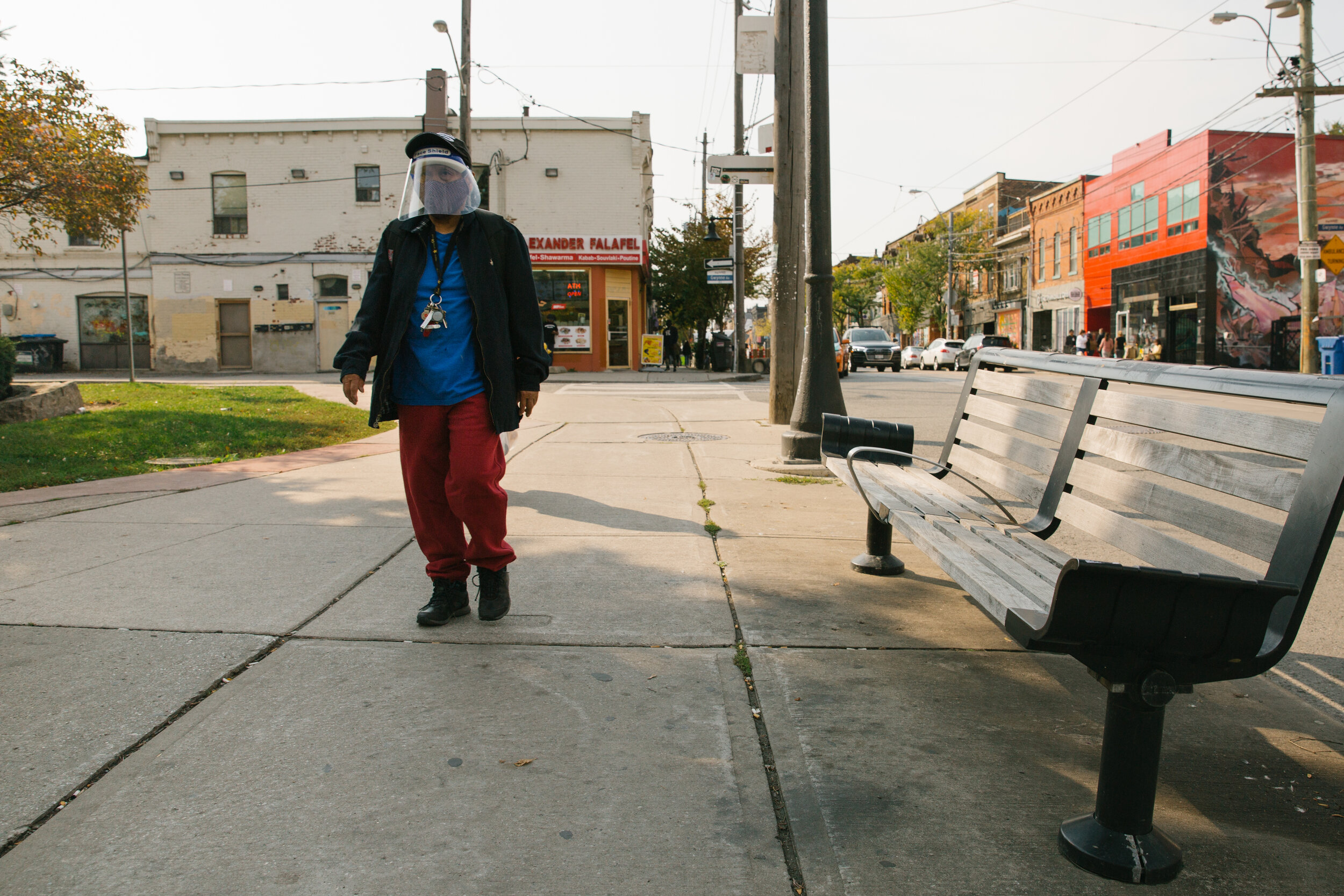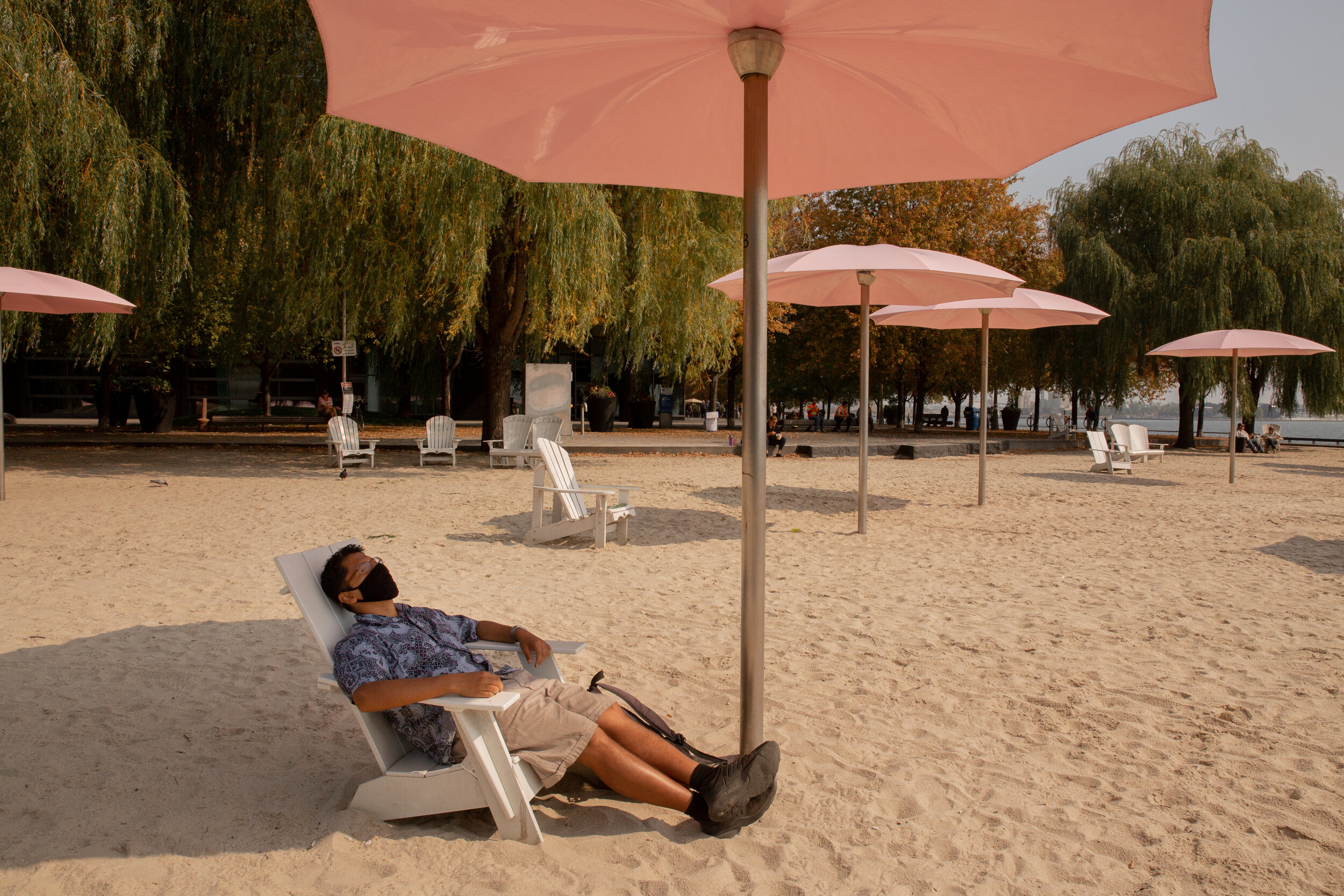
Ebti Nabag
SAFE IN PUBLIC SPACE: A PHOTO ESSAY
Over the course of the complete Safe in Public Space initiative, Toronto-based portrait and documentary photographer Ebti Nabag will travel beyond The Bentway site to public spaces city-wide, capturing communities’ changing interactions with their local parks, squares, and centres of communal gathering. Nabag’s work will examine, in real time, how ideas of safety manifest and are communicated in public space through borders and boundaries, signs and symbols, public space architectures, and delineations of space.
Who determines the rules for public space safety, and how are those rules indicated and enforced? How do communities — as the experts of their own experiences, cultures, and comfort levels — work to subvert and reshape established rules of public space safety to better suit their needs in rapidly-changing times? Follow the evolution of Ebti Nabag’s work through the release of weekly images that expose, from neighbourhood to neighbourhood and across the city at large, what it means to seek safety in public space.
Photographed in Parkdale, a man protects his face twice by covering it with a face mask and a face shield. In these times, maintaining a normal life and carrying on with a routine takes courage and resilience. How do you work around fear to start leading a somewhat normal life as we transition into life post quarantine?
Photographed in Scarborough, Qais who lives on the 8th floor comes down to meet Yusuf outside of his 2nd floor balcony. “We actually used to meet like this often earlier in the pandemic.” Qais says. Balconies have become the meeting place for many people during the pandemic. It’s that place between the indoor and the outdoor, the private and the public. From showing appreciation to the healthcare workers, to music parties and exercise classes, balconies have made community connections possible during isolation.
Photographed in Trinity Bellwoods, the exterior of the public bathroom is covered in Covid-19 signage. Even prior to the pandemic, public bathrooms served a vital need and had a pre-existing reputation of danger and risk. Accessibility has long been an issue. The excess signage adds another perceived layer of danger and reconsideration for use. But, if used while adhering to the rules, how unsafe are public bathrooms compared to other indoor spaces?
(1/2) Canadians should wear a mask as an "added layer of protection" says the Canadian Chief of Public Health. As COVID-19 spreads, you might find yourself under varying layers of protective measures when occupying public spaces. A man wearing a mask while under an umbrella at Sugar Beach relaxes in the summertime, protecting himself from the virus and the sun.
(2/2) While an eerily empty University of Toronto Scarborough campus uses garbage bags to keep students 2 meters apart amidst rising infection rates. Layers of protection, whether purpose-built or ad hoc, have changed the way we both work and play during these times.
(1/2) COVID-19 collides with a pre-existing pandemic, the pandemic of racism and discrimination. In Toronto’s downtown core, a Black Lives Matter protest captures the intersection between a novel virus and the systemic racism and discrimination Black people have long experienced in larger society. COVID-19 has further highlighted social inequities as the economic and public health crisis continues to disproportionately impact BIPOC communities.
(2/2) Around the world people have marched for long hours, experiencing an array of emotions ranging from anger and sadness, to unity and hope. Dancing has also become a vital component of peaceful protests. Black communities have learned to deal with trauma and pain through music and dance, as a way to express frustration and anger, but also as a way to bring people together.
(1/3) The statue of Egerton Ryerson, the architect of the residential school system, along with the statue of John A. Macdonald and King Edward VII were defaced in an art-based BLM protest in Toronto on July 18th. The statues exalt figures who have historically contributed to the oppression of BIPOC in Canada; as such, protesters demanded they be taken down.
(2/3) These monuments to figures that have negatively shaped our society have always been there, but it took the act of defacing them for their current context to become visible.
(3/3) Residues of the past have remained, emerging in new forms that continue to oppress BIPOC communities. These figures have inflicted intergenerational trauma, and their presence is a continuous reminder of that.
(1/2) Graffiti has been used to express the voice of city residents outside of traditional exhibition spaces. While street art contributing to the Black Lives Matter movement has been viewed by some as vandalism, it allows communities to reclaim their narratives and be heard. This silent work has an enormous visual impact, and can be more influential than speech alone.
(2/2) Street art comes in different forms. What at first appears to be an official street sign amongst Toronto city parking regulations is actually a notice that reads “Black Lives Matter 24/7, 365 days a year.” The sign is positioned next to a P Parking sign with time restrictions, subverting our expectations and playing on the idea of duration and urgency.
COVID-19 has further revealed Toronto’s housing crisis. During the pandemic, encampments created by those impacted by homelessness have appeared throughout Toronto’s public parks. In fear of contracting the coronavirus, residents of encampments argue that the public space tents provide safer living conditions than those offered by the shelter system. The City has worked to depopulate shelters, negotiating vacant buildings and hotels to house the homeless. However, the City’s accommodation efforts have not always been well received. Some homeowners residing in neighbourhoods proximate to tents or temporary shelters have protested over safety concerns. Similarly, those impacted by homelessness argue that the housing options provided by the City are located far from the social connections and services they often access in their communities.
Food security has been a growing issue in the city for more than a decade. Last year, a high number of residents were accessing food banks, that number has increased during COVID-19. Originally the city did not allow community gardens to open due to social distancing rules, as gardens were not seen as a necessity the same way grocery stores were. A petition to reopen community gardens was created and signed by other community gardens and community members that deemed gardens essential. The city soon realized that food is a necessity whether from a grocery store or a community garden and that communities need food security during this time. Historically, the community of Malvern has experienced an oversaturation of processed foods and limited access to affordable healthy food options. In 2009 a Malvern resident - with support from the community - started a garden in the back of their apartment building that sparked a local movement of residents preserving local green spaces to grow healthy, culturally appropriate food.
Now, Malvern has three community gardens supported by the Malvern Family Resource Center, and coordinated by members of the resident-led Malvern Food Security Work Group. The first is The Malvern Children Garden created for youth and children to grow and learn. The second is Little Roads Community Garden for hobbyists where a portion of their harvest is donated back, and the third is the communal Nelson Park Garden where 100% of the harvest is donated back to the community.
It is estimated that food insecurity affects almost 1 in 5 Toronto households. In the past few months, food pantries have been showing up in various communities throughout the GTA under the communal project Toronto Little Free Pantries. The pantries are made available for anyone in need of food supplies, and have provided an opportunity for community members to give back through labour and/or donated goods.
(1/2) To continue operating, outdoor recreational public spaces have the responsibility to assess and mitigate the risk associated with their activities. Implementing measures to reduce the risk of infection among those using the space means placing barricades or fences to section outdoor spaces into exterior and interior, in addition to rigorous cleaning protocols.
(2/2) While the rules of public spaces might be ambiguous, signs along the fence emphasize following safety measures once you are inside. These demarcations are required to keep the public safe; however, the rules within these spaces may well change the public’s navigation and perceived access.
New photos released weekly
EBTI NABAG
Ebti Nabag is a graduate of Ryerson University’s MFA program Documentary Media in Film and Photography. She is a Sudanese-Canadian visual artist who works with photography, video, and installation. She is also a digital and analogue photography instructor. She teams up with galleries and community organizations to deliver visual programs that provide opportunities for creative self-expression and aid in the development of identity. Her personal work is motivated by stories from the average human, and hopes her documentations serve as bridges between people and communities.


















